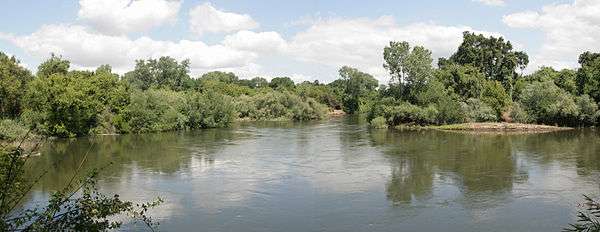Estanislao
| Estanislao | |
|---|---|
| Born |
Cucunuchi c. 1798 Río de los Laquisimes, Alta California |
| Died |
July 31, 1838 (aged 40) Mission San José, Alta California |
Estanislao (c. 1798 – 1838) was an indigenous alcalde of Mission San José and a member and leader of the Lakisamni tribe of the Yokut people of northern California . He was notorious for leading bands of armed Native Americans in revolt against the Mexican government and Mission establishments.
Early life

Estanislao was born with the Yokut name of Cucunuchi[1] circa 1793 on the riverbanks of the Río de Laquisimes (present-day Stanislaus River, Modesto, California). According to records at Mission San José, in 1821 mission padres had visited the Laquisimes area, and had insisted Cucunuchi to return to the mission along with his wife, daughter, and mother to receive a formal Christian education.[1] His younger brother Canocee had already visited the mission in 1820, and had been baptized with the name of "Orencio". Cucunuchi and his family journeyed to the mission on September 24, 1821, but his father did not go.[1] He was soon baptized with the name of "Estanislao" (Spanish for St. Stanislaw) after his arrival to the Mission San José.[1]
Life at the mission
Estanislao was the alcalde of the community before he left the mission with about 400 followers in 1827. Juan Bojorques describes Estanislao in his Recuerdos sobre la historia de California (1887) as "about six feet tall, his skin was more white than bronze, he was very muscular like a horse".[1] Juan Bautista Alvarado also mentions Estanislao's literacy in History of California (1876), he writes: "Estanislao was able to read and write and stood out among the leaders of other Central California Indian tribes".[1]
The group began raiding the Missions San José, Santa Clara, and Santa Cruz and Mexican settlers in the area around the Laquisimas River (now the Stanislaus River; during the later Mexican era, this river was called Rio Estanislao). Estanislao was joined by Chumash Indians led by Pacomio and by other Yokuts until at one time his army had 4,000 men. Estanislao educated his men in battle techniques he had learned from Spanish and Mexican soldiers. His raids were characterized as sudden, usually involving a trap, and ending with no loss of life, and he would sometimes use his sword to carve his initial, "S," authenticating his handiwork.
The Franciscan friars and Mexican settlers pleaded for help from the Mexican army. Finally, the Governor called the army into action. Three expeditions from the Presidio of San Francisco and the Presidio of Monterey failed to subdue the band. A fourth, larger force led by General Mariano Guadalupe Vallejo finally ousted Estanislao and his people from the Laquisimas River in the Spring of 1829. Both Vallejo and Estanislao were accused of brutality and atrocities by their forces in the battle.
Estanislao returned briefly to the Mission San Jose on May 31, 1829 to ask Father Narciso Duran for forgiveness for his men and himself. Father Duran successfully petitioned Governor José María de Echeandía to pardon Estanislao. The pardon was granted for Estanislao and his men on October 7, 1829.
Estanislao returned to the Laquisimas River to lead his people. Yoscolo, a Yokut Indian from the Mission Santa Clara, joined Estanislao's group in 1831. Yoscolo brought several hundred Indians with him from the Mission Santa Clara. Yoscolo and Estanislao led many raids against Mexican settlers. Yoscolo was different from Estanislao and did not mind killing Mexican settlers if he had to. Yoscolo sometimes wore a mask during his raids.
During the spring of 1833, malaria was introduced into the San Joaquin Valley by Canadian beaver trappers from the Hudson's Bay Company. More than 20,000 California natives died from malaria that spring, including Yokuts, Chumash, Miwok and others.
Later life
On August 24, 1834, Estanislao returned to the Mission San Jose and prospered there while teaching others the Yokuts language and culture. He remained at the Mission until his death, possibly from smallpox, on July 31, 1838. The Stanislaus River, Stanislaus County, and the failed Mormon settlement Stanislaus City (now Ripon) were named in his honor.
References
- A. Louis Koue (1960). "Mission San Jose de Guadalupe". Historic American Buildings Survey/Historic American Engineering Record. Library of Congress. Retrieved 2006-01-24.
- Alan Rosenus (1995). General Vallejo and the advent of the Americans. ISBN 1-890771-21-X.
- Thorne B. Gray (1993). The Stanislaus Indian Wars the Last of the California Northern Yokuts. ISBN 0-930349-01-6.
- Dorothy Krell; et al. (1979). A Sunset Book The California Missions a Pictorial History. ISBN 0-376-05172-8.
- James D. Adams (2006). Estanislao – Warrior, Man of God. ISBN 0-9763091-2-2.
- Frank F. Latta (1999). Handbook of Yokuts Indians. Brewer's Historical Press, Exeter. ISBN 1-892622-09-2.
- Bruce W. Miller (1988). Chumash: A Picture of Their World. Sand River Press, Los Osos. ISBN 0-944627-51-X.